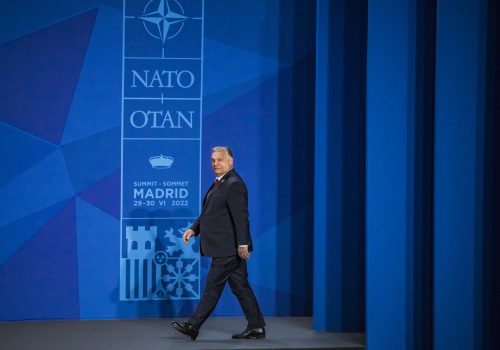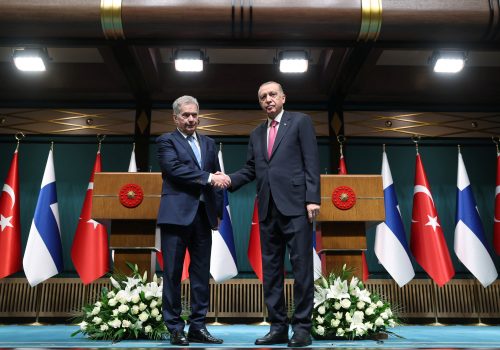Finland is undergoing two head-spinning political changes in the span of just a couple of days. First, on Sunday, Finland’s nail-biter parliamentary election resulted in the center-right National Coalition Party becoming the largest party in the new parliament. That gives the party and its chairman, Petteri Orpo, the right to be the first to try forming a coalition government.
In the international media there was a lot of surprise that Prime Minister Sanna Marin’s reign is coming to an end, given her high profile and popularity abroad. As is often the case, this election turned on domestic matters, even as its outcome will have far wider implications. Specifically, it was worries about the Finnish economy that seemed to give the decisive boost to the opposition. Marin’s center-left Social Democratic Party fell to third place, behind Orpo’s National Coalition and the populist Finns Party.
Then on Tuesday, Finland became the thirty-first member of NATO—officially ending the policy of military non-alignment. Finnish President Sauli Niinistö and key ministers traveled to Brussels for a flag-raising ceremony and to deposit the instruments of ratification. With the change of government, is there a reason to expect turbulence in Finland’s NATO path right after joining the Alliance?
Only by degrees, if at all. Security and defense policy have traditionally been areas of consensus in Finland. The decision to apply for NATO membership was backed by a strong majority of Finnish public opinion, and all the major parties in the new parliament are supportive of the accession. In fact, several outgoing members of parliament seem to have been voted out partially because of their anti-NATO sentiments. Finland is also set to continue its support to Ukraine in its defense against Russian aggression. Most members of parliament understand well that Ukraine is fighting for all of Europe, and it is Kyiv’s resistance against Moscow that gave Helsinki the time and space needed for a course correction in its defense policy, now culminating in the accession to NATO.
The fact that Finnish governments are always multi-party coalitions tends to be a moderating factor. The government program is a result of compromises. Continuity, especially in security policy, is always highly valued. While it is too early to surmise the exact composition of the new government, the continuity will be there. The president, with constitutional powers in the realm of foreign policy, will also represent continuity. Niinistö’s second and final term ends next year.
But some changes can be expected in the nuances of foreign and security policy. For example, the Finns Party tends to condone nationalist narratives and emphasizes the sovereignty of the country. This sometimes sits uneasily with the changes in the security environment calling for greater international cooperation across many policy areas, not least in security policy. While the Finns Party might still support greater cooperation in NATO since it is an intergovernmental organization and not a supranational one, issues like solidarity and multinational joint capabilities might put them in an uncomfortable situation. Of course, it is far from clear if the Finns Party will be in the next coalition government.
Meanwhile the National Coalition Party, which is likely to form the new government, is close to the Social Democrats when it comes to foreign and security policy but usually a bit more open to deepening cooperation with the United States.
It will also be interesting to watch the rhetoric of the incoming government. Marin gave a voice to the new generation of leaders who are accustomed to speaking their minds on issues of foreign and defense policy without mending their words. Most likely, there is no way of putting the genie back into the bottle and the discourse has changed for good. The other party leaders have in most cases embraced the new approach.
Other changes, brought on by NATO membership itself, will be much farther reaching over the long term. The technical interoperability between Finland and its new allies is at an excellent level, but that was always going to be the easy part. The challenge is in changing the culture surrounding Finnish policymaking to embrace mutual solidarity and open debate, and in fostering an understanding of Alliance dynamics and processes. Finland needs to know how to best leverage its policies, geopolitical position, and resources to drive its objectives in NATO. The new government will play a key role in this.
While the composition of the new government is still unknown, the other important question relates to the time needed to form the government. It might take weeks or months. In the meantime, the outgoing government will continue in a caretaker capacity. This will limit the possibilities for making major policy decisions, but it allows for running the daily business of government. The new government will hopefully be in place by summer. Absent an international crisis or a significant escalation of Russian activities against Finland, this transition period should pass smoothly. Even in a moment of massive change, Helsinki is doing its usual best to hold steady.
Rasmus Hindrén is a nonresident senior fellow with the Transatlantic Security Initiative in the Atlantic Council’s Scowcroft Center for Strategy and Security and the Head of International Relations at the European Center of Excellence for Countering Hybrid Threats.
Further reading
Tue, Mar 28, 2023
Hungary has approved Finland joining NATO. But its delays raise deeper concerns.
New Atlanticist By Petr Tůma
The problem of an unreliable Hungary will long outlast this foot-dragging over Sweden and Finland, and allies should be prepared to deal with an outlier that’s weakening the system from within.
Sat, Mar 18, 2023
Experts react: Turkey moves to approve Finland’s NATO membership. Where does that leave Sweden?
New Atlanticist By
After Turkish President Recep Tayyip Erdogan said he would approve of Finland's membership in NATO, our experts break down what's next.
Tue, Feb 7, 2023
What would happen if Sweden and Finland split up their NATO bids?
New Atlanticist By
Finland proceeding without Sweden should be a last resort because of all the strategic and logistical difficulties it would create.
Image: National Coalition Chairman Petteri Orpo celebrates at the party's parliament election wake after seeing the results of the advance votes in Helsinki, Finland, April 2, 2023. Lehtikuva/Antti Aimo-Koivisto via REUTERS ATTENTION EDITORS - THIS IMAGE WAS PROVIDED BY A THIRD PARTY. NO THIRD PARTY SALES. NOT FOR USE BY REUTERS THIRD PARTY DISTRIBUTORS. FINLAND OUT. NO COMMERCIAL OR EDITORIAL SALES IN FINLAND.



